Subscribe now to get notified about IU Jharkhand journal updates!
A study about the Employer's perspectives towards factors influencing Employee Retention in IT Service Industry
Abstract :
Technology is unfolding on many fronts. Innovation in the IT Industry is said to happen when some new attributes are added to the
existing technology. IT companies are recognizing the need and importance of innovation and growth in the economy. The
development in the field of technology is fueling the growth of all other industries. The emerging innovation in the technology is
actually disrupting the business functions and process. This disruption in the technology is bringing the growth curve down of the
companies. A big challenge to accept and adopt this disruption is faced by the industry. Due to the rapid change in the digital arena
some of the companies are facing it as a big time challenge to cope with the change.
There are many factors on which employee retention is depended and identifying this factor at the right time and implementing it
rightly is much more crucial. As rightly said that every story has two sides, the same way the other side of employee retention is
employee turnover, which means the total number of employees parting every year with the organization. It can be voluntary leaving
the organization or Involuntary parting with the organization. There are different policies that encourage the employees to stay with
their organization for a longer period of time. Retaining employees does not mean that the organization should or need to retain each
and every employee rather it means to retain those employees who have proved to be the best employees for the organization, for
example, employees who are good performers, loyal to company rules and policies, contributing towards the growth of the company
etc.
As said by David Sirota that “You can't expect people to be committed, to be loyal to an organization, to be engaged in an
organization, or to want to stay in an organization if the company doesn't care about them.”
Keywords :
Employee Turnover, Retention Strategies, Attrition, Retaining Employees etc.Introduction
One of the fastest growing industries is the Information
Technology Industry. The Indian IT industry is growing,
although faster and has gained a lot of equity in the global
market. It industry in India comprises of the software
industry and the information technology enabled services
industry. Both of them have added a lot of revenue and
advantage to the Indian economy. Technology has proven
to be quite beneficial for the citizens of the country. With
the development of technology in the world, it has become
easy and efficient to be connected every time with others.
Works or jobs that used to take days to time to be done by
the employees of any organization are being done in just a
few hours today all because of technology development.
With the growth of our economy and the development of
the technology, a large number of opportunities are
available in the market. Competition with the
organizations has increased so much that each company
needs to have the competitive edge to survive for a longer
period of time. India has been identified as the as the
largest sourcing destination for the Information
Technology Industry. The IT Industry contributes a lot
towards the social and economic transformation of the
country. IT Industry has provided a completely new look
to India on the global platform. This industry is
accelerating the economic growth of India. India has a
unique selling proposition when it comes to IT Industry in
the global sourcing market, as the competitiveness in
providing the IT services from India is two to three times
less than any other country in the world.
Technology has made many works of the human being
easy and fast. Technologies are created and developed to
improve the human being's life. Companies use the
technologies to become more effective and efficient.
Technology is helping the organizations deliver what the
customers desire for the organization. Organizations are
using these technologies to do things more creatively.
With the development of the smart devices, millions of
people are connected every second of the minute. In the
early days, the computers used to be without the
networking capabilities. But today we can access any data
from anywhere or can send loads of information any
corner of the world through the Internet or external
devices. Today internet has changed almost everything.
Because of the high speed, inexpensive and easily
available nature, the Internet has made it easier for the
people to access information. With the high demands in IT,
development is happening very rapidly. It is helping
people to do business differently. But technology doesn't
change things overnight; there are many projects that fail
in the beginning.
LITERATURE REVIEW
All over the world, retaining skilled employees is a big
concern in almost every industry. Managers are facing an
increasingly high rate of attrition in the organization. The
business environment is becoming more competitive and
they keep making skilled employees as their competitive
edge. Employee retention is important as this helps in
sustaining the environment. Employee retention is
important for organizational growth. Recent studies have
proved that employee retention of the highly skilled
employees is becoming a difficult task for the management
of the organization. Employees of the IT industry are being
attracted by the other organizations in the market. The
rival companies are ready to attract and employee the
employees of the other organizations. The competitive
organization offers better package and policies to attract
the best skilled employees.
According to Anitha (2014), organizations are
continuously loosing on the skilled employees and are
facing a big challenge in retaining these employees.
Organizations recruit the most skilled candidates from the
market, but they are not capable of retaining these highly
skilled employees for a longer period of time. The
employees who put their hundred percent have some
expectations from the organization as well and the
organizations do not satisfy the employees they tend to
leave the organization sooner in a very short period of
time. If the managers of the organization are not able to
identify the reason why these employees are leaving the
organization, then they will never succeed with any of the
retention strategies.
Das and Baruah (2013) stated that a set of appropriate
retention strategies need to be used in order to retain the
skilled employees. Employees need to be treated as the
differentiating assets who are profitable always and act as
the non depreciating asset of the company. Skilled
employees are that asset whose rewards organizations
reap every time. Role of employee retention is important
for each and every organization. Adopting to the retention
strategies makes a path for the organizations to sustain in
the competitive environment. Various models have
proven to be beneficial for the organization to survive in
the market. Researchers have linked employee turnover
with the recruitment sources said Anitha (2014). They pay
less attention towards the retention of the skilled
employees. Employees run the organization but at times
the organizations forget to treat them well.
Anitha (2014) said in her study that the employee turnover
occurs when the employee leaves the organization and
that vacant position needs to be filled with the equal or
similar capable candidate. Replacing the existing
employees is costly and also has a destructive impact on
the organization. Thus the management should work on
the reduction of the movement of the employees from the
organization, particularly those employees who are
crucial for the operation of the organization said Sherman
et al. (2006). Retention is a voluntary action by the
organization so as to retain the employees for a longer
period of time. Loss of employees has an adverse effect on
the productivity and service of the organization. Retention
of high performing employees is attracted and employed
by the organizations said Budhwar et al. (2003). But it may
happen that the employee will leave the organization as
the other rival companies will hire the employee.
Objectives
- To study and analyze the psychographic factors influencing the retention of employees in the IT Service Industry in Bengaluru.
- To conceptualize and prioritize the different Factors influencing Employee Retention.
Hypotheses
H01: Opportunities for career growth provided by the
organization does not significantly influence Employee
Retention.
H02: Employee Retention is not significantly influenced
by the remuneration provided by the organization if it's at
per industry standards.
H03: Employee Retention is not significantly influenced if
opportunities resulting Promotion are available in the
organization.
H04: Good and healthy Working Environment does not
significantly influence Employee Retention.
H05: Stress reduction programs like yoga, meditation,
health care, etc. conducted by the organization does not
significantly influence Employee Retention.
H06: Flexibility in Working Hours emphasized by the
organization does not significantly influence Employee
Retention.
H07: Respect & Fair Treatment received from managers
and other employees does not significantly influence
Employee Retention.
H08: Opportunities available to develop New Skills does
not significantly influence Employee Retention.
H09: Promoting Work Life Balance by the organization
does not significantly Employee Retention.
H010: Approachable and co-operative supervisor does not
significantly influence Employee Retention.
Methodology
For the above study both Primary and Secondary data
were collected and used to analyze the relevance of
retention strategies. For Primary data a Questionnaire
(containing 10 questions related to the psychographic
factors) was prepared and distributed among the HR's of
different companies and to collect secondary data
comprehensive review of existing literature i.e., Journals,
Books, Magazines, Internet and Newspapers was
undertaken to know the contemporary attrition and
employee retention scenario.
1. Career Growth
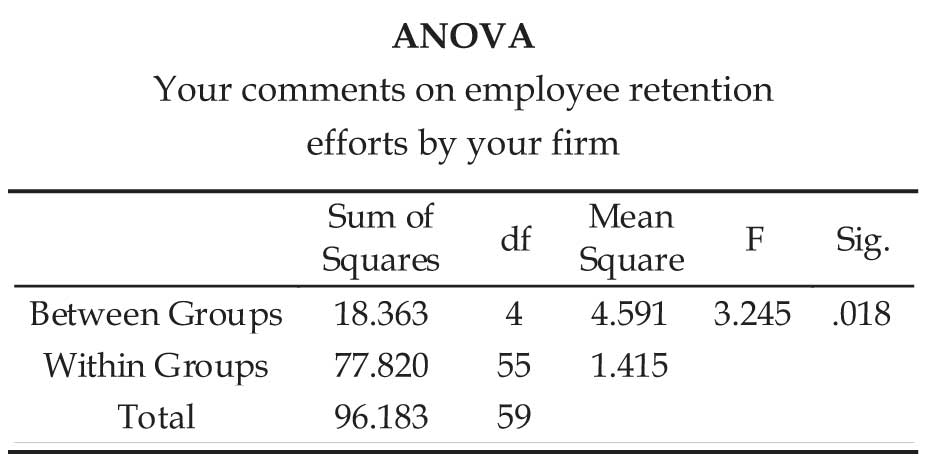
H:Career Growth will not influence the efforts by the
organization towards employee retention variable. The
level of significance set by us is 5%, i.e., á = 0.05. The table
reveals that p value is less than the á value. In fact, since p =
0.018 is less than á = 0.05, the null hypothesis is not
accepted and the alternate hypothesis is accepted. That
means, Career Growth significantly impact the retention
of employees.
2. Remuneration
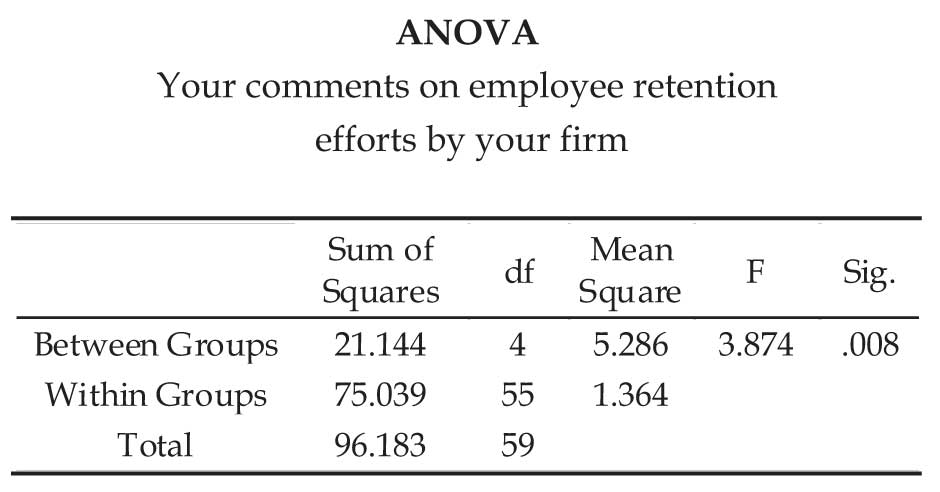
H:Remuneration will not influence the efforts by the
organization towards employee retention variable. The
level of significance set by us is 5%, i.e., á = 0.05. The table
reveals that p value is less than the á value. In fact, since p =
0.008 is less than á = 0.05, the null hypothesis is not
accepted and the alternate hypothesis is accepted. That
means, Remuneration significantly impact the retention of
employees..
3. Opportunities resulting Promotion
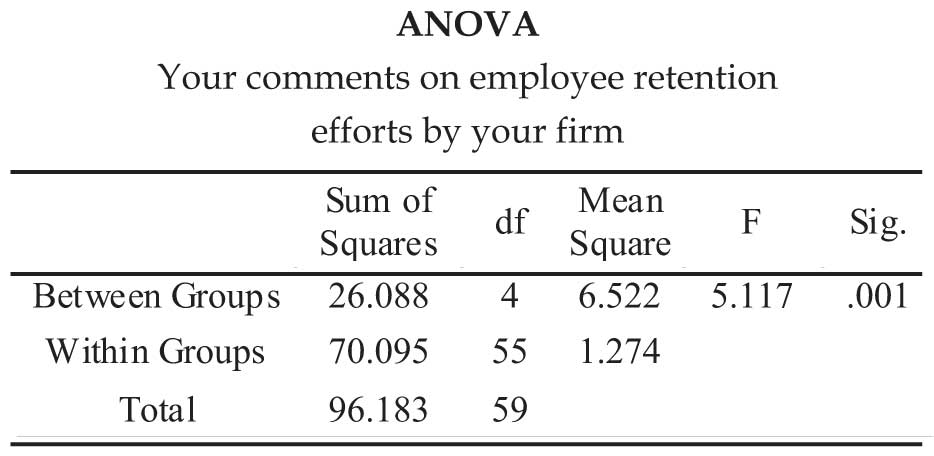
H:Promotion will not influence the efforts by the
organization towards employee retention variable. The
level of significance set by us is 5%, i.e., a = 0.05. The table
reveals that p value is less than the a value. In fact, since p
= 0.001 is less than a = 0.05, the null hypothesis is not
accepted and the alternate hypothesis is accepted. That
means, Promotion significantly impact the retention of
employees.
4. Healthy Working Environment
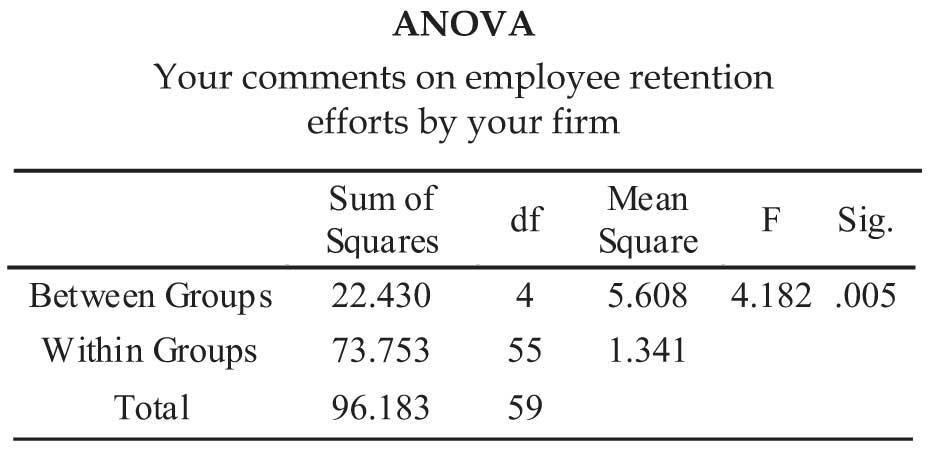
H:Work Environment will not influence the efforts by the
organization towards employee retention variable. The
level of significance set by us is 5%, i.e., á = 0.05. The table
reveals that p value is less than the á value. In fact, since p
= 0.005 is less than á = 0.05, the null hypothesis is not
accepted and the alternate hypothesis is accepted. That
means, Work Environment significantly impact the
retention of employees.
5. Stress Reduction Programs
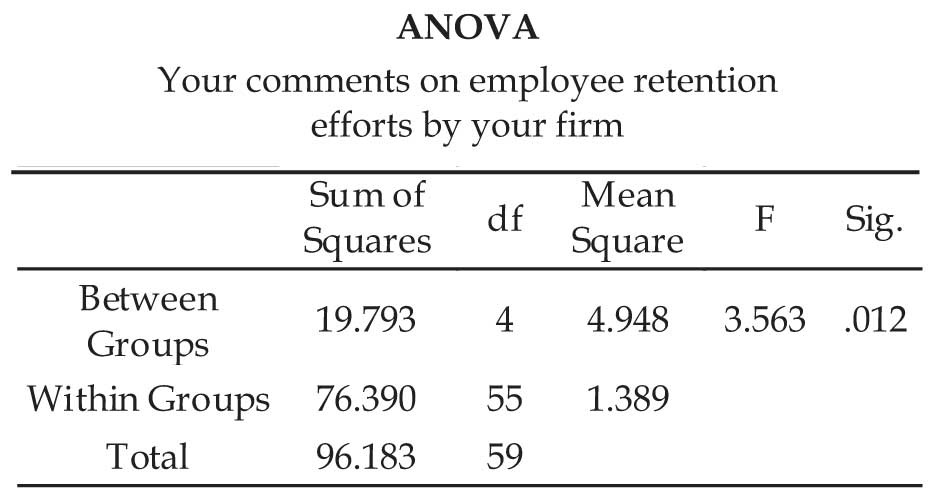
H:Stress Reduction programs will not influence the efforts
by the organization towards employee retention variable.
The level of significance set by us is 5%, i.e., á = 0.05. The
table reveals that p value is less than the á value. In fact,
since p = 0.012 is less than á = 0.05, the null hypothesis is
not accepted and the alternate hypothesis is accepted. That
means, stress reduction programs significantly impact the
retention of employees.
6. Flexibility in Working Hours
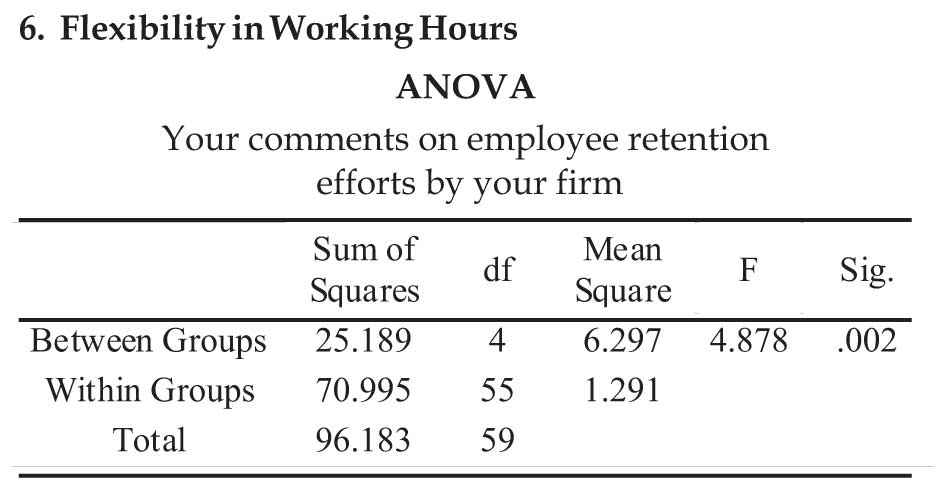
H:Flexible Work Hours will not influence the efforts by the
organization towards employee retention variable. The
level of significance set by us is 5%, i.e., a = 0.05. The table
reveals that p value is less than the a value. In fact, since p =
0.002 is less than a = 0.05, the null hypothesis is not
accepted and the alternate hypothesis is accepted. That
means, flexibility in working hours significantly impact
the retention of employees.
7. Respect and Fair Treatment
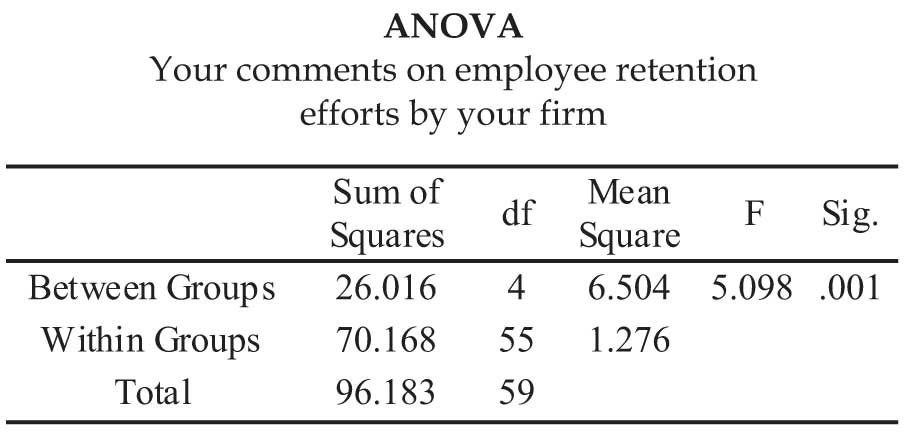
H:Respect & Fair Treatment will not influence the efforts
by the organization towards employee retention variable.
The level of significance set by us is 5%, i.e., á = 0.05. The
table reveals that p value is less than the á value. In fact,
since p = 0.001 is less than á = 0.05, the null hypothesis is
not accepted and the alternate hypothesis is accepted. That
means, respect & fair treatment significantly impact the
retention of employees.
8. Opportunities to develop New Skills
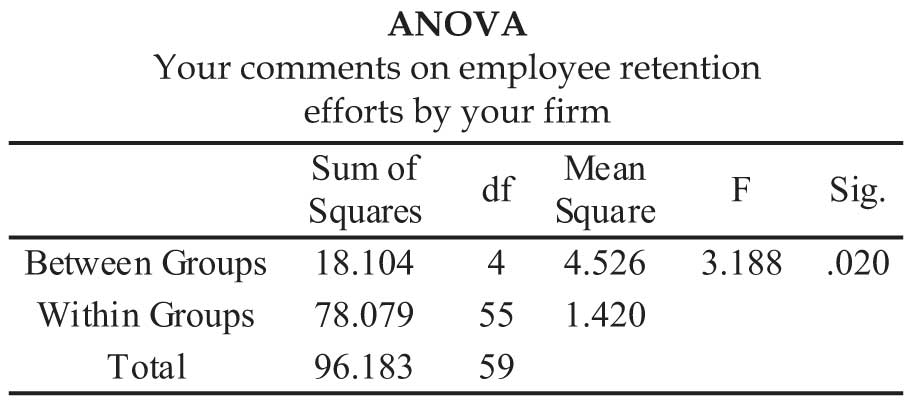
H:Opportunites to develop new skills will not influence
the efforts by the organization towards employee
retention variable. The level of significance set by us is 5%,
i.e., á = 0.05. The table reveals that p value is less than the á
value. In fact, since p = 0.001 is less than á = 0.05, the null
hypothesis is not accepted and the alternate hypothesis is
accepted. That means, opportunities to develop new skills
significantly impact the retention of employees..
9. Work Life Balance

H:Work Life balance will not influence the efforts by the
organization towards employee retention variable. The level of
significance set by us is 5%, i.e., á = 0.05. The table reveals that p
value is more than the á value. In fact, since p = 0.137 is more
than á = 0.05, the null hypothesis is accepted and the alternate
hypothesis is rejected. That means, work life balance
significantly does not impact the retention of employees.
10. Approachable and Cooperative Supervisor
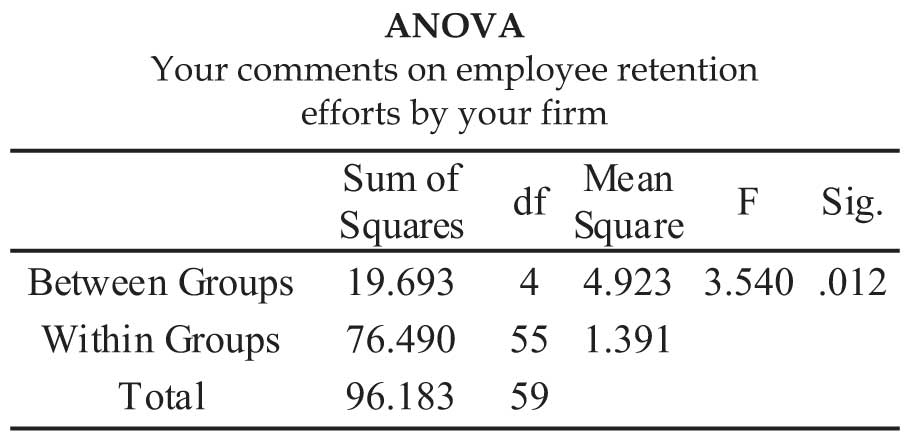
H:Approachable and Cooperative supervisor will not influence
the efforts by the organization towards employee retention
variable. The level of significance set by us is 5%, i.e., á = 0.05.
The table reveals that p value is more than the á value. In fact,
since p = 0.012 is less than á = 0.05, the null hypothesis is not
accepted and the alternate hypothesis is accepted. That means,
work life balance significantly impact the retention of
employees.
Priortization of the Factors
The standardized regression coefficients (i.e. Beta) is a measure
of how strongly each predictor variable influences the criterion
variable and higher the Beta Value the greater is the impact of the
Predictor variable on the Criterion variable.
Below table reveals that â value for foctor 3 is the highest, i.e.,
0.199. In fact, the variable, i.e. opportunities resulting promotion
has high impact on the retention of employees. Similarly, the â
value factor 5 is the lowest, i.e., 0.014. It means, this variable
stress reduction programs has the least impact on the retention of
employees. Thus, out of the seven positive variables identified,
on the basis of degree of influencing positively, the priority list is
as follows; factor 3, factor 10, factor 7, factor 1, factor 6, factor
4and factor 5.
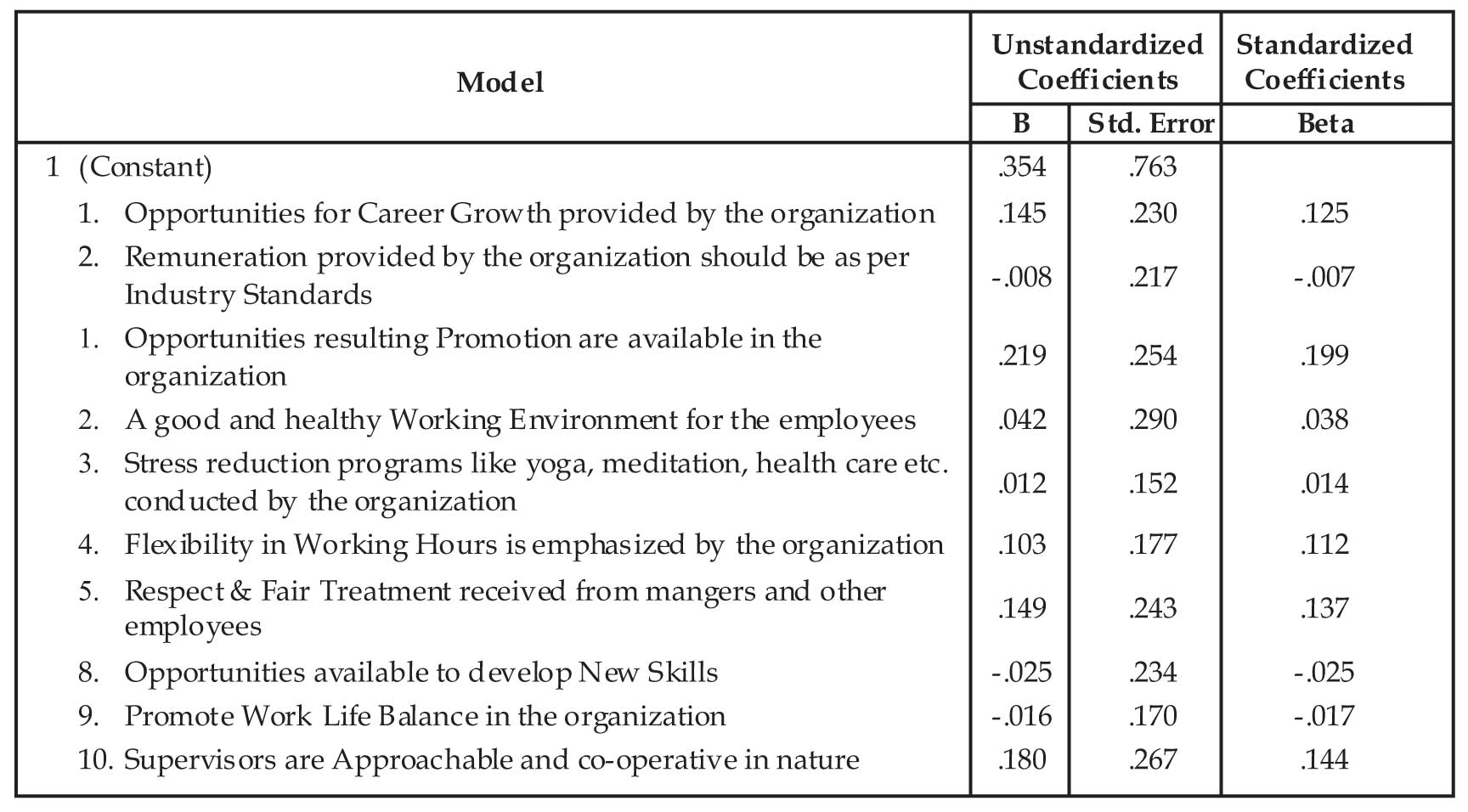
CONCLUSION
It has been observed and researched that an organization
where the employees are not valued or their skills are
unutilized prolifically or they are not heard, would lose
them out to other organizations. This creates a lot of chaos
in the minds of employees and employer unable to
decipher the root cause for attrition. From the study it was
found that retention of employees is largely dependent on
four components i.e. Competition, Environment, Growth,
Relationship and Support. It is imperative on behalf of
Employer to motivate the employees on all factors in order
to retain the employees. Staying with the organization for
a longer period of time not only benefits the organization
but also the employee.
This study helped in exploring the measures taken by the
employers. The findings made it very clear that there is no
single approach that can be used to retain employees. Also
the old age strategies are proving to be outdated and
ineffective with gen X,Y and millenials. With the massive
changes in the work and the workplace, it has become
important to work on executing the retention strategies
rather than them just being on papers. Retention is a
combination of various factors which vary in their
importance from organization to organization. Today
organizations have realized that the success of the
business is determined by the quality of the talent of the
overall workforce. Recruiting and retaining the skilled
and talented employees is a very difficult task and
consumes a lot of time and efforts of the organization.
Often the cost associated with employee turnover is
ignored by the employers which results in a huge loss to
the organization. IT executives are reporting higher
turnover rates these days and that the employer should
work and concentrate on the retention strategies rather
than hiring strategies.
References :
- Anitha, J. (2014). Determinants of employee engagement and their impact on employee performance”, International Journal of Productivity and Performance Management, Vol.3,pp.308-323. Retrieved from http://dx.doi.org/10.1108/IJPPM-01- 2013-0008.
- Das, B.L. and Baruah, M (2013). Employee Retention: A Review of Literature. IOSR Journal of Business and Management. (IOSR-JBM), e-ISSN: 2278-487X, p-ISSN: 2319-7668, 14, 2 (Nov. - Dec. 2013), 08-16.
- Sherman, D., Alper, W. and Wolfson, A. (2006). Seven Things Companies can do to Reduce Attrition”, Journal of South African Institute of People Management, 24(3): 8-11.
- Budhwar, P.S. (2003). Employment relations in India. Employee Relations, 25, 2, 132 – 148.
